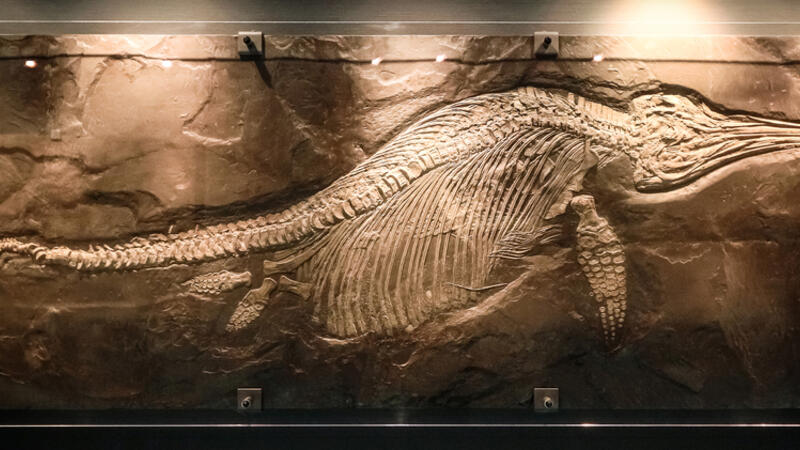Paleontologists have unearthed the well-preserved skeleton of the large-bodied predatory ichthyosaur species Temnodontosaurus trigonodon at Rutland Water Nature Reserve in the UK.
Dr. Dean Lomax with the skeleton of Temnodontosaurus trigonodon. Image credit: Anglian Water / Leicestershire and Rutland Wildlife Trust / Matthew Power Photography, www.matthewpowerphotography.co.uk.
Temnodontosaurus trigonodon belongs to an extinct genus of ichthyosaurs from the Early Jurassic epoch.
First described in 1843, this species lived in the deeper areas of the open ocean between 200 and 175 million years ago.
It fossilized remains are curently known from Western Europe and Chile.
The newly-discovered skeleton of Temnodontosaurus trigonodon is approximately 180 million years old.
It was discovered by Rutland Water Conservation team leader Joe Davis during the routine draining of a lagoon island for re-landscaping in February 2021.
At over 10 m (33 feet) long, this is the biggest and most complete skeleton of its kind found to date in the UK.
It is also thought to be the first Temnodontosaurus trigonodon found in the country.
“The find has been absolutely fascinating and a real career highlight, it’s great to learn so much from the discovery and to think that this amazing creature was once swimming in seas above us, and now once again Rutland Water is a haven for wetland wildlife albeit on a smaller scale,” Davis said.
“It was an honor to lead the excavation,” sai Dr. Dean Lomax, a paleontologist and a visiting scientist affiliated with the University of Manchester.
“Britain is the birthplace of ichthyosaurs — their fossils have been unearthed here for over 200 years, with the first scientific dating back to Mary Anning and her discoveries along the Jurassic Coast.”
“Despite the many ichthyosaur fossils found in Britain, it is remarkable to think that the Rutland ichthyosaur is the largest skeleton ever found in the UK.”
“It is a truly unprecedented discovery and one of the greatest finds in British paleontological history.”
“I’ve been studying the Jurassic fossil reptiles of Rutland and Leicestershire for over twenty years,” added Dr. Mark Evans, a researcher with the British Antarctic Survey and a visiting fellow at the University of Leicester.
“When I first saw the initial exposure of the specimen with Joe Davis I could tell that it was the largest ichthyosaur known from either county. However, it was only after our exploratory dig that we realised that it was practically complete to the tip of the tail.”
“Rutland’s motto, ‘Multum in Parvo,’ translates as ‘Much in Little’ so it is fitting that we’ve found Britain’s largest ichthyosaur skeleton in England’s smallest county.”
“It’s a highly significant discovery both nationally and internationally but also of huge importance to the people of Rutland and the surrounding area.”
“The block containing the massive 2-m- (6.6-foot) long skull weighs just under a ton (comprising the fossil, the Jurassic clay in which it lies, and the encasing plaster of paris and wooden splints),” said Dr. Nigel Larkin, a paleontological conservator and a visiting research fellow at Reading University.
“The block containing the body section weighs about 1.5 tons. It’s not often you are responsible for safely lifting a very important but very fragile fossil weighing that much. It is a responsibility, but I love a challenge. It was a very complex operation to uncover, record, and collect this important specimen safely.”
Source: sci.news













